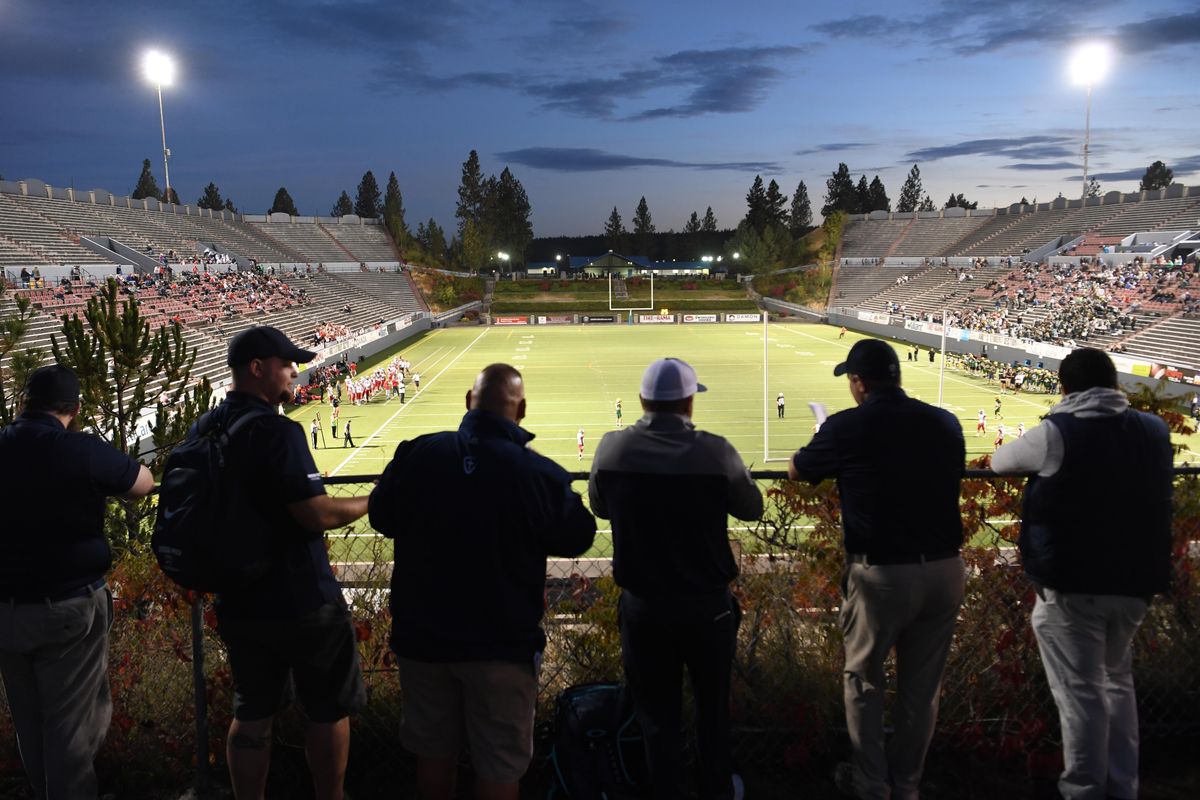School bond measure would replace Joe Albi Stadium; new location still to be decided

“The urban experience,” Spokane Mayor David Condon calls it, that certain something that draws people to a city and holds them there.
And gives them something to cheer – as long as they don’t get too grumpy over finding a parking spot.
“I think that for Spokane, the urban experience is about arts, culture and sports,” Condon said last week as he expounded on the desirability of a new high school outdoor stadium downtown to complement Spokane Veterans Memorial Arena.
The Arena has been a fixture since 1995. And now a new indoor sportsplex on the north bank of the Spokane River is nearing the design phase.
A 5,000-seat stadium downtown would complete the trifecta, say backers of a stadium, including the mayor. It also has the potential to host outdoor music events.
If voters approve next month’s $495 million bond measure, Spokane Public Schools would have about $31 million to demolish 68-year-old Albi Stadium in northwest Spokane and replace it.
The question is “Where?” At the Albi site? Or downtown?
The big crowds of yesteryear’s football games have collapsed in recent years. Instead of thousands of fans jamming Albi, the crowds have dwindled to a few hundred. No one is predicting a new stadium will reignite football game attendance, but a new stadium downtown, backers say, will continue what they call a renaissance transforming the north bank.
The bond and stadium siting will be left to voters to decide, sort of.
While funding for a new stadium is folded into the overall bond, there is a separate nonbinding advisory vote on the stadium location.
School board members will listen to voters, but ultimately they will decide where a stadium gets built if the bond passes.
Based on recent history, that may not be easy. The downtown stadium site includes a financial and logistical hurdle that doesn’t apply to the Albi site: parking.
It is estimated that an extra $10 million is needed for the downtown stadium site to pay for a possible parking garage.
The school board balked at the controversy and punted the entire stadium siting issue to the city.
The stadium advisory vote may be close. A survey conducted by the school district in July with 1,000 online participants “came out about 50-50” on where to build, according to associate school superintendent Mark Anderson.
The vision for a downtown stadium is clouded by many questions:
Will the parking be free for high school events? Yes. The Spokane Public Facilities District – which would manage the downtown stadium – has assured the school district parking will be free for school district events.
Is a $10 million parking garage still part of the project? Maybe. A recently completed survey shows that parking in the Arena area is underutilized, lessening the need for a parking garage. Meanwhile, the city has reached out to facilities such as Rock Pointe, to expand parking options.
If the stadium remains in northwest Spokane, would it still hold 30,000 seats? No. Regardless of location, the new stadium would have a capacity of 5,000. That’s because no matter where the new stadium is built, the district will build a new middle school near the Albi site, and a larger stadium wouldn’t allow enough space.
Would traffic be manageable with the addition of a new stadium and sportsplex? Probably. The city is nearing full implementation of an intelligent traffic system that, according to Mayor Condon, would dissipate traffic faster than at the Albi site.
Why can’t the district move football and other sports back to high school sites, as the Mead and Central Valley districts have done? The district says “no,” because individual stadiums are costlier to build and maintain. Also, parking and lighting are insufficient at current school sites.
The biggest uncertainty is the look and feel of the stadium itself. Early renderings are “very preliminary (and generic) to ensure it could fit,” said Rick Romero, who heads special projects for the city.
Those drawings appear to show a bare-bones stadium that would fit within the project’s proposed boundary. However, Anderson said the stadium – regardless of where it’s built – will include artificial turf, lighting, a sound system and scoreboard, concessions, restrooms, two locker rooms and a ticket booth.
Because of the constraints of city streets, the downtown stadium would have a north-south orientation. That also would give patrons a view of Riverfront Park and downtown to the south.
Lost in the hand-wringing over the downtown location is the potential impact of expanded playing fields for soccer and other sports at the Dwight Merkel complex near Albi.
Condon contends that the expansion of Merkel could make the facility an attractive venue for regional soccer events, but the financial impact is unclear.